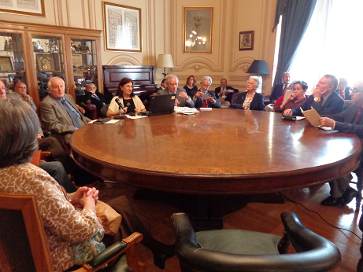The Fundación Iberdrola España is taking part in a conference on the new lighting for the Church of El Paular
The Villa y Corte Foundation has organised a conference on the new ornamental lighting in the Church of the Monastery of Santa María de El Paular which was recently inaugurated. This is a result of an initiative undertaken thanks to a cooperation agreement between the Iberdrola Spain Foundation and the Directorate General of Fine Arts and Cultural Heritage to light the altarpiece, bearing the cultural importance of this church in mind.

This is a result of an initiative undertaken thanks to a cooperation agreement between the Iberdrola Spain Foundation and the Directorate General of Fine Arts and Cultural Heritage to light the altarpiece.
This informative day included presentations from the Iberdrola Foundation’s head of Art and Culture, Carmen Recio and the architects from the DIRDAM36 Studio Carlos Salas and José Sanchez, who often collaborate on lighting projects.
Attendees even included the Prior of the Monastery, Father Miguel Muñoz, and members of the Association of Friends of El Paular, who also supported this lighting project and were able to learn about some other examples of the over thirty lighting projects undertaken by the Iberdrola Foundation in Spain.
The new lighting emphasises the most valuable piece in the monumental complex: the multicoloured alabaster altarpiece by artists from the school of Juan Guás in the late 15th century. Helping to highlight the historic and artistic heritage is the main goal of the Iberdrola Foundation’s Illumination Programme, says Carmen Recio, who highlights the use of the latest LED technology, which gives improved energy efficiency (75% better on average than traditional bulbs) and lower maintenance costs due to a much longer working life. Along with the artistic, economic and environmental benefits, Recio emphasised the potential of these projects that contribute towards supporting economic activity and facilitate local development around the historic and artistic heritage. This programme also contributes towards achieving the UN’s Sustainable Development Goals (SDGs) and has a direct impact on these targets: protecting cultural heritage (Goal 11), improving energy efficiency (Goal 7) and promoting sustainable tourism (Goal 8).
The architects Salas and Sanchez, pointed out the project’s most significant technical features (separate Paular link). The special lighting treatment used for the altarpiece, combining accent lights for the different scenes and the work on the vaulting with spotlights on the top cornice to give continuity to the length of the nave and provide uniform lighting respecting the atmosphere of the surroundings and the natural light.
